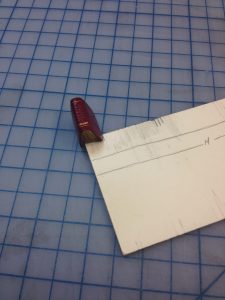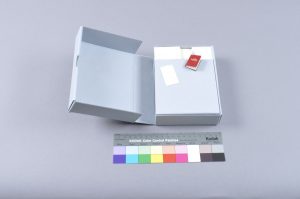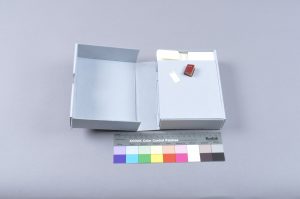Written by Tedd Anderson, Conservation Technician
Welcome to Part Two of EXTREME ENCLOSURES: Miniatures.
If you ever want to feel like some sort of extreme being (a giant, perhaps, or even better: Andre the Giant), you may want to take a gander at the tiniest books that Rubenstein Library has to offer: the miniatures. The raw power you feel when holding five leather bound books in the palm of your hand is astounding. Rubenstein has almost two hundred miniature books. These little guys, known as The Minis, are often bullied by the notorious “big boys of the stacks.” Once again, Conservation has to step in to take care of at-risk books. We needed to help the Minis bulk up so they are not beat up by larger books or lost in the wild (albeit highly climate controlled) world of the stacks.

The miniatures had previously been housed in folders within document boxes; usually a dozen or so in each box. One may handle multiple volumes before finding the one they wish to access. Once the desired volume is finally found, it can be easily lost due to its miniscule size. To facilitate handling we wanted to house them individually in standard size corrugated clamshell boxes (aka “pizza boxes” or “drop spine boxes.”). First we had to decide on what that standard size would be.
The height of the standard box was set by the 8-inch-high shelves. To determine the width and depth of the standard box, I measured each miniature to find the largest amongst them. I settled on a standard box that would measure 6 inches x 1.75 inches x 4 inches. An added advantage to a standard box is the ability to batch tasks. I would measure, cut, and crease 30 or so clamshells at a time, saving a lot of time.


Once I had the standard clamshells figured, I had to determine how to settle the books into their new houses without them rattling around. I wanted to keep the inserts simple and intuitive. After a few experiments, I chose a two-tiered system of spacers made from corrugated board adhered with double stick tape. I added Volara and 10 point card stock tabs to further stabilize when necessary. Watch as this Mini “Addresses of Lincoln” gets a house.







When finishing up the nearly two hundred enclosures for all these vulnerable Minis I rejoiced. Knowing how intimidating other large volumes can be to the slighter books in the collection, it’s nice to know a conservation technician can make a petite book’s size anxiety just a little less extreme. I am comforted that the Minis now rest easy: safely tucked away in their soft foam and supportive board havens, never to feel lost or intimidated again.

Several adequately housed Minis basking in their new security:
Be sure to visit part one of Extreme Enclosures: Boxing the Audubons.





